Social media is a hungry beast with an insatiable craving for content. In the old days, marketers used to build a campaign out of a killer headline, a few lines of carefully crafted copy, and a single great image. Churn out a few different formats across print, outdoor, and TV; and Donald Draper’s your uncle.
In case you’ve been living under a rock for the last decade, things have changed. Mad Men style campaigns still have their place, and Ogilvy’s words of wisdom still ring true. But, these days you really need to feed the beast of social media if you’re going to cut through the noise that is the internet.
What does that mean?
It means posting regularly. Simple as that. No, you don’t need to post everyday. All you ‘social media gurus’ need to stop spouting that rubbish. Please. It doesn’t apply to most brands. Also, that’s not really Gary Vee’s point, go and read what he says again.
‘Regular’ is going to mean different things to different brands. For most of our clients, three a week per platform, with a complimentary ad campaign running at the same time, is about right. Your mileage may vary, of course.
That’s still quite a bit of content. Let’s assume:
- Your brand is active on three platforms
- You post three times per week on each platform
- You run two ad campaigns per month, with six ad variations in each
That’s 51 pieces of content per month. (3 x 3 x 52 / 12) + 12 if you want the maths. Here in New Zealand, we’re used to working with small teams and even smaller budgets. Not many companies have a dedicated social media manager. The ones that do social media inhouse, that person is generally doing a bunch of other stuff as well.
Pumping out that much content, promoting it all cleverly, managing your community, reporting, meetings with management, yikes! Chuck a couple of blog posts in there, and things start to look a little pie in the sky.
So, how are you supposed to do it?
Confession time: we don’t know a lot about how you inhouse people function. Having skills across all of those disciplines – you must be super heros.
What we do know though, is how to streamline a production cycle so you have the best chance of success, and you don’t go crazy trying. As an agency of twelve people, Mosh produces around 300-400 pieces of content each month. Each item has words and imagery (whether that’s a photo, graphic, video or animation), and spans Facebook, Instagram, LinkedIn, Twitter and more. With a small team, it’s essential that we’re as efficient as possible. Today, we’re going to share some of that secret sauce; how we manage to produce quality and quantity without working ourselves mad.
It’s all outlined below, but if you prefer just watch the video:
If reading is more your thing, here’s an outline. In a past life I was a graphic designer, so let’s start with a graphic.
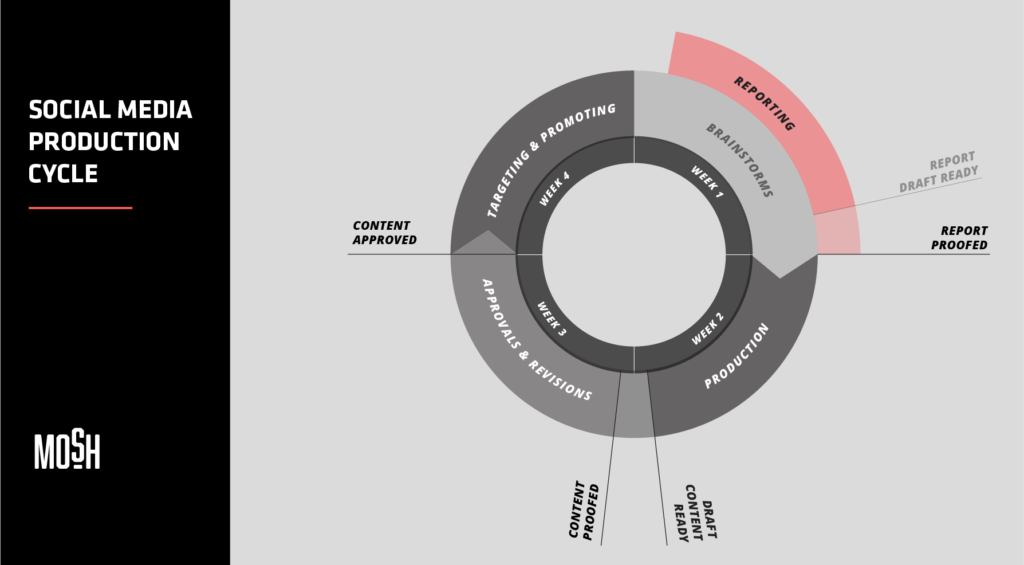
Whoa! That’s complicated, let’s break it down.
One revolution of the cycle is a month, and we break it up into four weeks (yes yes, a month isn’t exactly four weeks, no need for the pedantry, you know what we mean).
In our situation, roughly half of our clients are aligned with calendar months, and half are mid-month to mid-month. This helps with bottlenecks, and gives us options around start dates when we’re onboarding new clients.
Each week has a specific goal.
Week 1: Brainstorms
Key output: high level content calendar with ideas plotted
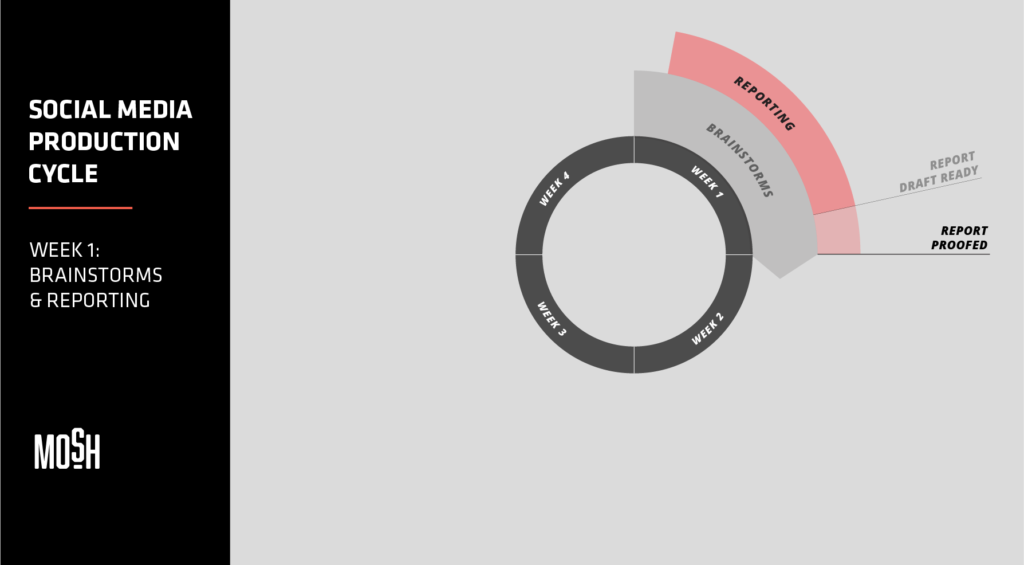
In the first week we’re coming up with ideas. And we don’t mean staring out the window daydreaming, waiting for inspiration to hit. We mean:
- Looking at the broader marketing calendar
- Looking at the regular calendar (what’s coming up, Mother’s Day, school holidays, events etc
- Looking at what your competitors and peers are doing
- Having a structured brainstorm with other relevant members of your team (we’ll do another post about how to do this, subscribe to our socials if you want to know when that comes out)
Week one is also reporting week. So, at the same time as all this ideating, we’re putting together the report for the previous month. So the previous month’s performance (best post, worst post, that sort of thing) is front of mind as we’re coming up with ideas. Genius!
Week 2: Production
Key output: proofed content
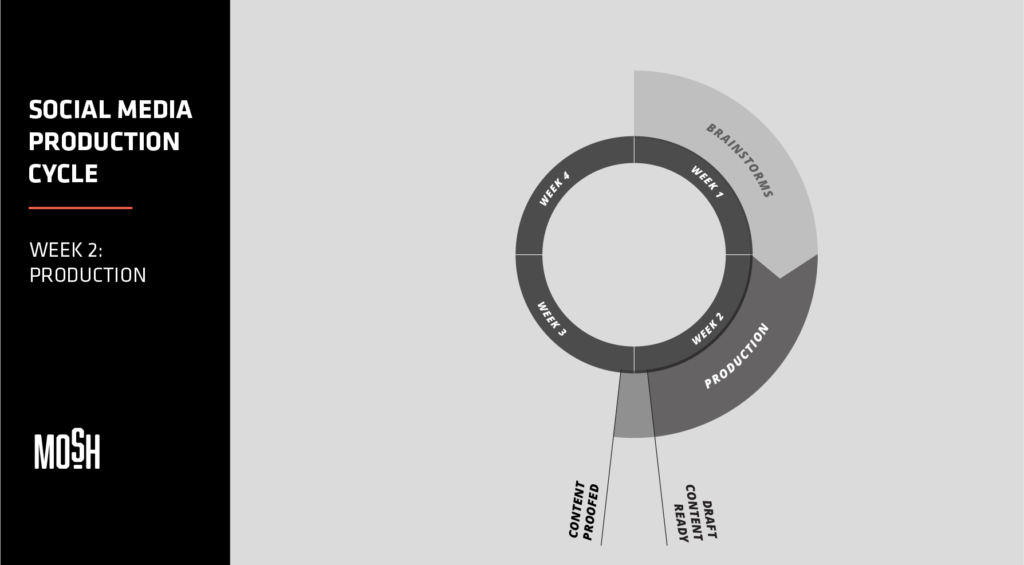
Once the plan is in place, it’s time to start making. Graphics, videos, and copy. If you have a solid strategy and an approved plan, this should be easy. Get those headphones on, queue up your favourite high energy playlist, and crack on. Make sure there’s time allowed for proofing, and make sure someone else is doing that step. You can’t proof your own work, it never works!
Week 3: Approvals & Revisions
Key output: approved content
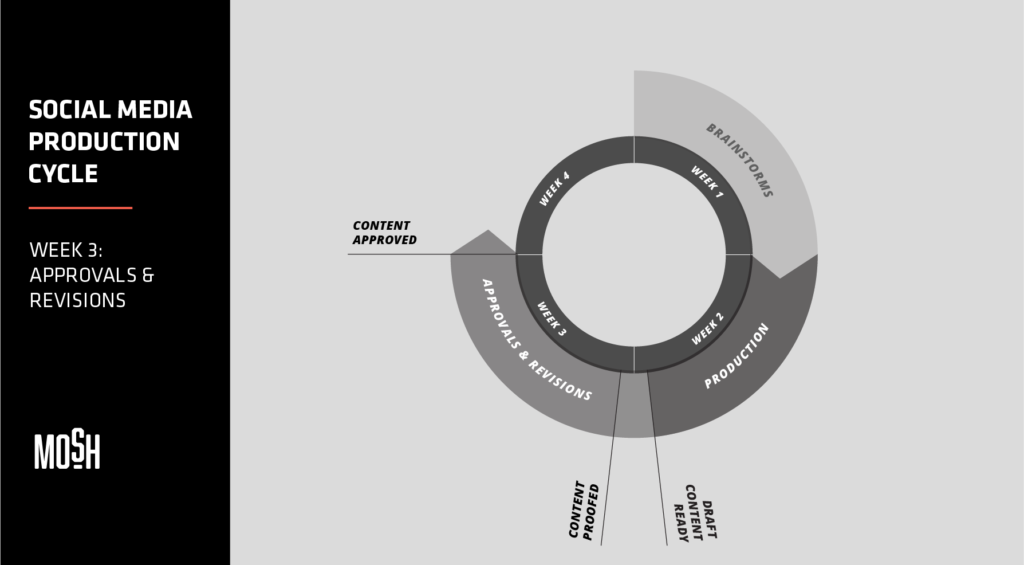
Yes, a whole week for this bit! It’s important to know who has final say, and make sure they know the due date for approvals. In reality there’s always quite a few cooks in the kitchen, that’s unavoidable. That’s why it takes time.
Week 4: Targeting & Promotion
Key output: everything scheduled
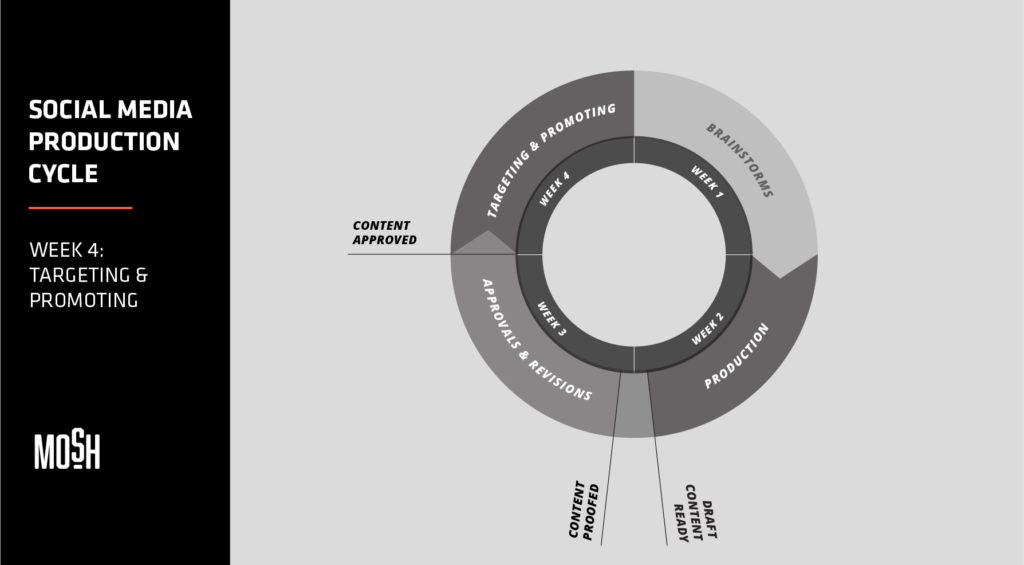
Now it’s time to get into your ad platforms of choice, whether that’s Facebook Ads Manager, LinkedIn Campaign Manager, Twitter Ads, or one of the many others. Refer to your strategy, align audience targeting with the content, schedule everything with appropriate durations, and get your objectives in place.
Wow, that was easy!
Well, no not really. Social media isn’t easy, anyone who tells you that is drunk or lying. It’s fast paced, creatively demanding, technically complicated, and forever changing. That’s why a rock solid production cycle like this is absolutely essential. Without it, we’d have gone loopy years ago.
By leaving a comment you agree with the storage and handling of your data by this website. You can learn more about how we handle you comment information in our Privacy Policy. We are using Akismet to reduce comment spam. Learn how they process your comment data.